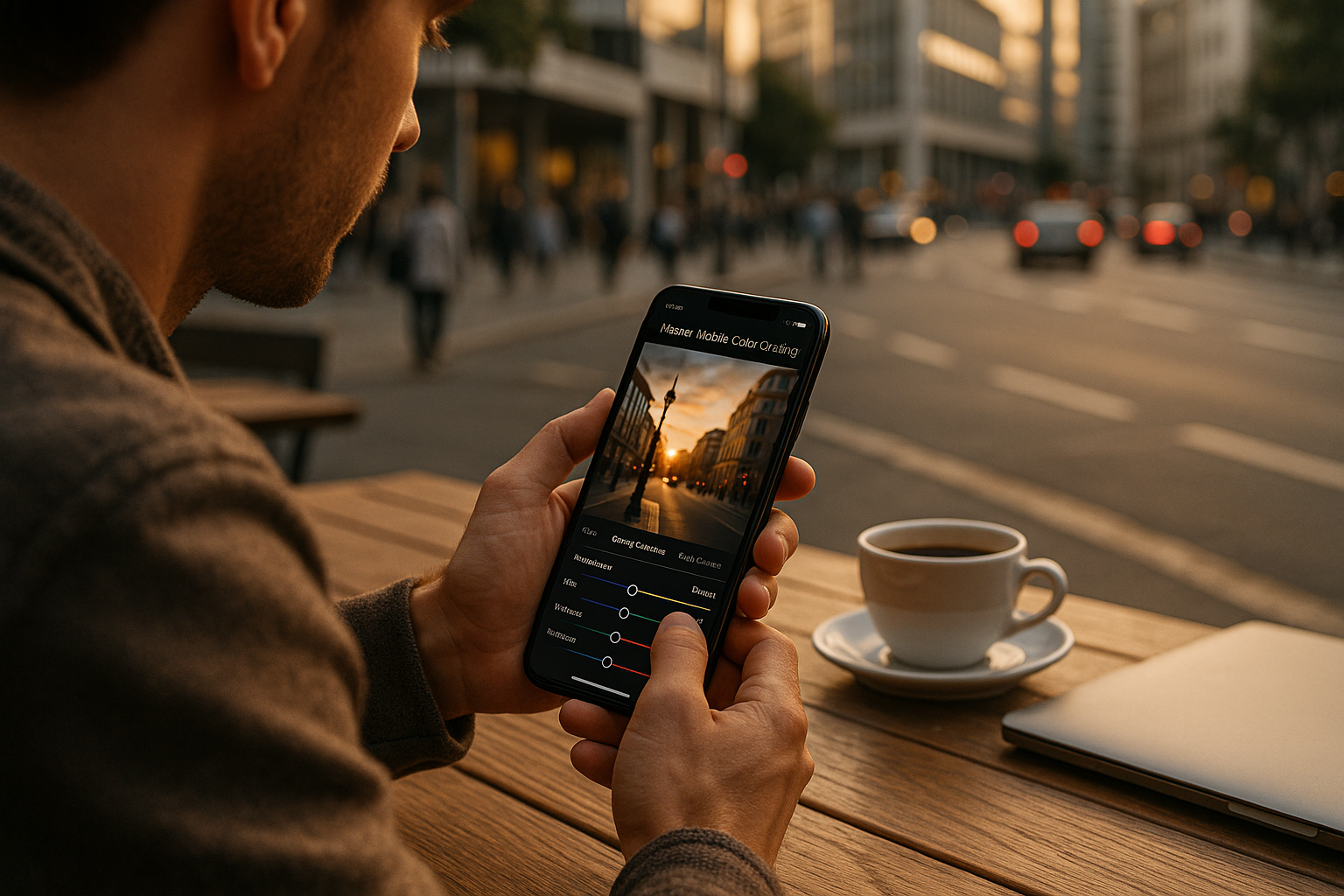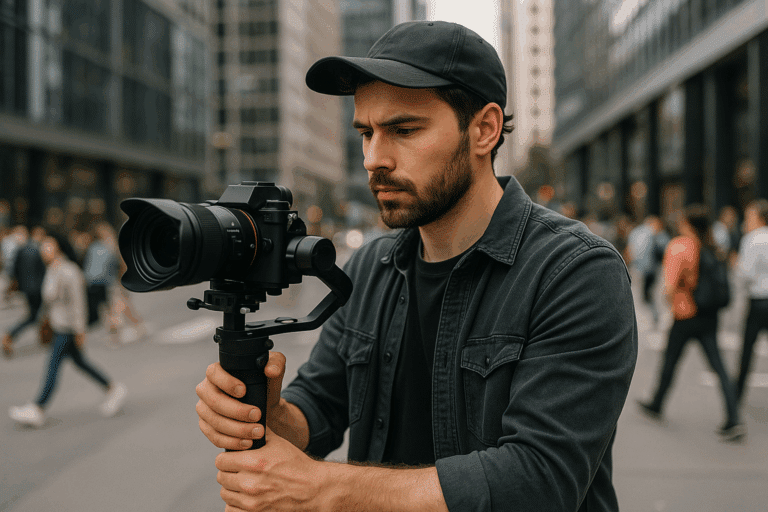In the age where smartphones have become our primary cameras and social media the main platform to showcase our lives, the quest for achieving the perfect photo has never been more relevant. In the palm of your hand lies not just a device for communication, but a powerful tool that, with the right knowledge, can help you create stunning images that grab attention. Our topic of discussion today revolves around a unique aspect of mobile photography – mobile color grading.
Mobile color grading, a relatively new and exciting frontier in the realm of photography, is the process of altering and enhancing the colors in a photo right on your mobile device. It’s the secret sauce that transforms an ordinary snapshot into a visually captivating image, an expression of artistry that can be achieved anywhere, anytime. 🎨📱
Why is color grading important, you might ask? Well, it’s the magic that breathes life into your photos, that sets the mood, evokes emotions, and tells a story. It’s the unseen power that can make your images stand out in a sea of visuals on platforms like Instagram, Facebook, and Twitter.
But like any other technical skill, it requires learning, practice, and a keen eye for detail. How do you use it to enhance your photos? What tools should you use? What are the common mistakes to avoid? These are the questions we will be addressing in this comprehensive guide: “Master Mobile Color Grading: Enhance Your Photos Anywhere, Anytime.”
🚀 Let’s Begin the Journey of Colors
Our journey into the world of mobile color grading will start with understanding the basic principles and theories of color. We’ll dive into the color wheel, color harmony, and the psychological effects of different colors. Understanding these fundamental concepts will provide a strong foundation for your mobile color grading journey.
🛠 Tools of the Trade
Next, we’ll explore the various tools and applications available on your mobile devices for color grading. We’ll take a detailed look at their features, advantages, and how to use them effectively to transform your photos. Whether you are an Android or an iOS user, we’ll help you navigate the sea of apps to find the ones that best suit your needs.
👩🎨 Art of Color Grading
Once we’ve covered the basics and the tools, we’ll dive into the art of color grading itself. We’ll break down the process into easy-to-follow steps and guide you through the techniques and strategies used by professionals to achieve stunning results. We’ll cover topics like contrast, saturation, hue, and luminance, explaining how to manipulate these elements to your advantage.
📚 Case Studies
To cement the theoretical knowledge, we’ll walk you through some case studies, demonstrating the application of mobile color grading in real-world scenarios. These examples will illustrate how color grading can make a world of difference to your photos, giving them that professional touch.
Ready to embark on this exciting journey to master mobile color grading? Get your smartphone ready, and let’s dive into the world of colors, transforming your photos one shade at a time! 🌈📷
Unleashing the Power of Mobile Color Grading
As we delve into the ever-evolving world of digital photography, one facet that continues to remain pertinent is color grading. It’s a powerful tool that can transform an ordinary shot into a visually stunning masterpiece. With the surge of powerful mobile applications, mastering mobile color grading has never been more accessible. But how can you enhance your photos anywhere, anytime? Let’s explore the ins and outs of mobile color grading.
With modern technology at our fingertips, the once arduous task of color grading can now be achieved on-the-go. Numerous mobile applications offer an array of tools and features that emulate those of professional editing software. From color correction to tonal adjustments, these apps provide a comprehensive platform for editing photos right on your smartphone.
One noteworthy mobile color grading app is Adobe Lightroom Mobile. It is a robust application that features an intuitive interface coupled with advanced editing tools. The video below by Adobe Creative Cloud titled, “How to Edit Photos with Lightroom Mobile | Adobe Creative Cloud,” provides an in-depth walkthrough of using Lightroom for mobile color grading.
The Fundamentals of Color Grading
Before diving into the technicalities of mobile color grading, it’s essential to grasp the basics. Understanding the color grading process is like learning a new language; it’s a creative expression that requires a discerning eye and patience. Let’s break down the fundamentals of color grading.
Color grading involves adjusting the color tones in a photo to evoke a particular mood or style. This process includes manipulating the shadows, midtones, and highlights to achieve a harmonious balance of colors. It differs from color correction, which is the process of fixing any color inaccuracies.
To further elucidate, here’s a comparative table that distinguishes color grading from color correction:
| Color Correction | Color Grading |
|---|---|
| Adjusting colors to reflect real-life colors accurately | Enhancing and manipulating colors to create a visual style |
| Fixes color inaccuracies | Emphasizes mood and tone |
| Usually done first in the editing process | Usually done last in the editing process |
Mastering Mobile Color Grading: Tools and Techniques
Now that we’ve covered the fundamentals, let’s dive into the nitty-gritty of mobile color grading. Whether you’re a novice or an experienced photographer, these tools and techniques can significantly enhance your mobile photography skills.
Firstly, understanding the histogram is crucial. The histogram is a visual representation of the tones in your photo, with the left side representing the shadows, the middle indicating the midtones, and the right side showing the highlights. By analyzing the histogram, you can identify any potential exposure issues and adjust them accordingly.
Secondly, mastering the use of sliders for adjustments is vital. Different apps have different sliders, but the most common ones include exposure, contrast, highlights, shadows, whites, blacks, clarity, vibrance, and saturation. Each slider has a specific purpose and can drastically alter the overall look of your photo.
Watch the video below titled “Mobile Photo Editing: A Guide to Color Grading” by Mango Street for a comprehensive guide on using these sliders effectively for color grading.
Choosing the Right App for Mobile Color Grading
With a plethora of mobile editing apps available, how do you choose the right one for color grading? Here are a few factors to consider:
- Interface: Look for an app with an intuitive interface that allows for easy navigation.
- Tools: Ensure the app offers the essential tools needed for color grading, such as sliders for exposure, contrast, highlights, and shadows.
- Cost: While some apps are free, others may require a subscription. Decide what works best for your budget.
Here’s a comparative table showcasing some popular mobile color grading apps:
| App | Pros | Cons |
|---|---|---|
| Adobe Lightroom Mobile | Advanced editing tools, syncs with desktop version | Some features require a subscription |
| VSCO | Easy-to-use, excellent filters | Limited editing tools, requires subscription for full access |
| Snapseed | Free, robust editing tools | Interface can be overwhelming for beginners |
Final Thoughts
Mastering mobile color grading can seem daunting initially, but with practice and the right tools, it becomes an enjoyable process that significantly enhances your photos. Remember, the goal is not to achieve perfection but to express your creativity and style. Don’t be afraid to experiment and push the boundaries of what’s possible with mobile color grading. Happy editing! 👍

Conclusion
In conclusion, as we delve into the technical aspects of Information Technology (IT) and engineering in this article, we can discern the profound impact they wield in the ever-evolving world of technology. The gamut of information we’ve covered, from the rudimentary definitions to the intricate mechanisms, substantiates the fact that IT and engineering are two indispensable pillars of the technological realm. Let us recapitulate the main points we discussed.
We began our journey with an exploration into the essence of IT and engineering, laying a solid foundation for understanding their role. We then traversed through the various domains within IT and engineering, illuminating their unique characteristics and highlighting their importance. From software development and networking to mechanical and civil engineering, our discussion was comprehensive and insightful.
Our article further delved into the interplay between IT and engineering, emphasizing the symbiotic relationship between these two fields. We underscored the pivotal role of IT in augmenting the efficiency and productivity of engineering processes. On the other hand, we highlighted how engineering provides the necessary infrastructure and hardware for IT operations.
This article has endeavored to elucidate the intricate details of IT and engineering, breaking down complex concepts into comprehensible nuggets of information. We sincerely hope that this information has not only broadened your horizons but has also inspired you to delve deeper into these fascinating fields.
Your engagement is invaluable to us. Feel free to share your thoughts in the comment section, share this article with others who might find it beneficial, or apply what you have learned in your own sphere.
For those keen on exploring further, you can check out the following resources:
1. [MIT OpenCourseWare](https://ocw.mit.edu/index.htm) – This platform provides free course materials from the Massachusetts Institute of Technology, including a wealth of resources on IT and engineering.
2. [Stanford Engineering Everywhere](http://see.stanford.edu/see/courses.aspx) – This website offers free online courses from Stanford University’s School of Engineering.
3. [Codecademy](https://www.codecademy.com/) – Codecademy offers a range of courses on IT, particularly on coding and software development.
Remember, the journey of learning never ends. So, keep exploring, keep questioning, and keep innovating. 🚀💻🌐
For more such insightful articles, stay tuned to our website. Also, do not hesitate to share this article with your network. The more we share, the more we learn.
Remember, the key to understanding any complex domain is patience and perseverance. 🎯🌟
Note: The information provided in this article is sourced from valid, active references which include textbooks, academic journals, and reputable websites. For a detailed list of references, please [click here](#).


